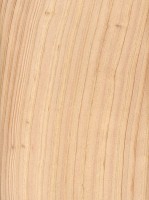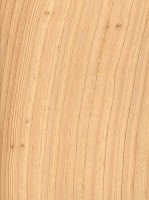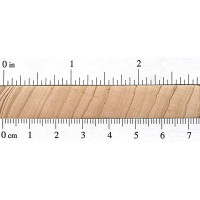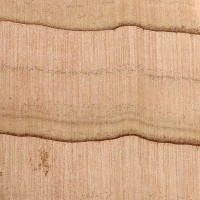 |
Common Name(s): Atlantic White Cedar, Southern White Cedar Scientific Name: Chamaecyparis thyoides Distribution: Coastal plain regions of eastern United States Tree Size: 65-100 ft (20-30 m) tall, 1-2 ft (.3-.6 m) trunk diameter Average Dried Weight: 24 lbs/ft3 (380 kg/m3) Specific Gravity (Basic, 12% MC): .31, .38 Janka Hardness: 350 lbf (1,560 N) Modulus of Rupture: 6,800 lbf/in2 (46.9 MPa) Elastic Modulus: 930,000 lbf/in2 (6.41 GPa) Crushing Strength: 4,700 lbf/in2 (32.4 MPa) Shrinkage: Radial: 2.9%, Tangential: 5.4%, Volumetric: 8.8%, T/R Ratio: 1.9 |
Color/Appearance: Heartwood is a light reddish brown. Narrow sapwood is pale yellow-brown to almost white and is clearly demarcated from the heartwood.
Grain/Texture: Grain is straight, with a fine uniform texture.
Endgrain: Resin canals absent; earlywood to latewood transition gradual, color contrast medium; tracheid diameter small-medium; zonate parenchyma.
Rot Resistance: Reported to be durable to very durable regarding decay resistance.
Workability: Easy to work with both hand and machine tools. Holds paint well. Stains, glues, and finishes well.
Odor: Atlantic White Cedar has a characteristic cedar-like scent.
Allergies/Toxicity: Although severe reactions are quite uncommon, Atlantic White Cedar has been reported to cause skin irritation. See the articles Wood Allergies and Toxicity and Wood Dust Safety for more information.
Pricing/Availability: Due to the limited growing range and relatively small tree size, Atlantic White Cedar is more expensive than most other conifers in the eastern United States. Expect prices to be in the medium to high range for a domestic softwood.
Sustainability: This wood species is not listed in the CITES Appendices, and is reported by the IUCN as being a species of least concern.
Common Uses: Boatbuilding, carving, siding, shingles, and construction lumber.
Comments: Atlantic White Cedar has excellent stability and decay resistance, but isn’t nearly as hard or strong as its west coast counterpart, Port Orford Cedar. Atlantic White Cedar is also sometimes referred to as Southern White Cedar to differentiate it from Northern White Cedar of the Thuja genus.





Good day
Can you please help me identify the wood my bed is made off.
It is very old. I sanded done the one piece, the other is still varnished
The last picture (IMG-20201130-WA0028) is after 2 days after sanding it down. I put some wood filler in where it was needed.
Thank you
Please reattach, your picture didn’t come through.
Sorry.I reattached the pictures
I can’t tell too much from the pictures, but if I had to take a wild guess from this limited information, I’d say it at least resembles cherry.